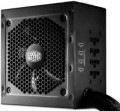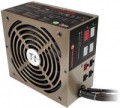Efficiency
Efficiency, in this case — the ratio of the power of the power supply (see "Power") to its power consumption. The higher the efficiency, the more efficient the power supply, the less energy it consumes from the network at the same output power, and the cheaper it is to operate. Efficiency may differ depending on the load; the characteristics can indicate both the minimum efficiency and its value at an average load (50%).
It should be noted that compliance with one or another level of 80PLUS efficiency directly depends on this indicator (for more details, see "Certificate").
Fan size
The diameter of the fan(s) in the power supply cooling system.
The large diameter allows to achieve good efficiency at relatively low RPMs, which in turn reduces noise and power consumption. On the other hand, large fans are more expensive than small ones and take up a lot of space, which affects the dimensions of the entire PSU. We also emphasize that a small fan is not yet a sign of a cheap power supply — quite advanced models can also have such equipment, in order to reduce dimensions.
As for specific diameters, the smallest value that can be found in modern consumer-grade PSUs is
80 mm. The most popular option is
120 mm, this size gives good efficiency and a relatively low noise level at a reasonable price and dimensions. Larger diameters are somewhat less common —
135 mm and
140 mm.
Certification
The presence or absence of an 80+ certificate for the power supply. This certificate indicates high energy efficiency: to obtain it, the efficiency (see above) must be at least 80%, and in different modes (20%, 50% and 100% of the maximum load). There are several degrees of 80+:
—
80+. The original version of the certificate, assuming an efficiency of at least 82% (at least 85% for 50% load).
—
80+ White. The second name of the original 80+ certificate (see above).
—
80+ Bronze — efficiency not less than 85% (for half load — 88%).
—
80+ Silver — respectively 87% (90% for half load).
—
80+ Gold — 89% (92% for half load)
—
80+ Platinum — 90% (94% for half load).
—
80+ Titanium — 94% (96% for half load).
The power factor (see "PFC Type") must be at least 0.9 for the lower levels and at least 0.95 for the Platinum level. Also note that for redundant power used in server systems, the efficiency requirements are somewhat lower.
ATX12V version
A standard for power supplies that supplements the ATX specifications regarding power supply along the 12 V line. Introduced into use since the time of the Intel Pentium 4 processor. In the first series of the standard, the +5 V line was mainly used; from version 2.0, the +12 V line was introduced to fully power the components computer. Also in the second generation, a 24-pin power connector appeared, used in most modern motherboards.
EPS12V version
The version of the EPS12V standard that the power supply complies with. The EPS12V standard was created primarily for high consumption PCs (with a power of more than 700 W, see "Power") and entry-level servers. Such power supplies have a 24-pin plug for the motherboard and an 8-pin processor power connector (sometimes more than one, see “MB / CPU Power” for more details). They are also more reliable than ATX12V. They are compatible with most ATX standard motherboards, however, in older motherboards, there may be problems with matching connectors, so this issue should be clarified separately (however, to solve this problem, in some power supplies, parts of the plugs are made removable, which allows them to be reduced if necessary to the dimensions of the connectors on the motherboard).
MOLEX
The number of Molex (IDE) connectors provided in the design of the power supply.
Initially, such a connector was intended to power peripherals for the IDE interface, primarily hard drives. And although the IDE itself is completely obsolete today and is not used in new components, however, the Molex power connector continues to be installed in power supplies, and almost without fail. Almost any modern PSU has at least
1 – 2 of these connectors, and in high-end models this number can be
7 or more. This situation is due to the fact that Molex IDE is a fairly universal standard, and with the help of the simplest adapters, components with a different power interface can be powered from it. For example, there are Molex - SATA adapters for drives, Molex - 6 pin for video cards, etc.
PCI-E 6pin
The number of 6-pin (6pin) PCI-E power connectors provided in the power supply.
Such connectors are used for additional power supply of those types of internal peripherals for which 75 W is no longer enough, supplied directly through the PCI-E socket on the motherboard (video cards are a typical example). The 6-pin connector on the power supply additionally provides another 75 W — thus, when using this connector, it becomes possible to connect boards with a power consumption of up to 150 W.
Note that some video cards have several connectors for additional power at once. Thus, the PSU can provide both
one PCI-E 6pin plug, and
two such connectors. However, in general, this type of plug is used quite rarely — this is due to the spread of a more convenient and versatile 8pin connector in the “6 + 2” format, which can be used both as six- and eight-pin (see below for more details).
PCI-E 8pin (6+2)
The number of PCI-E 8pin (6+2) power connectors provided in the PSU design.
Additional PCI-E power connectors (all formats) are used to additionally power those types of internal peripherals for which 75 W is no longer enough, supplied directly through the PCI-E socket on the motherboard (video cards are a typical example). In PC components, there are two types of such connectors — 6pin, providing up to 75 W of additional power, and 8pin, giving up to 150 W. And the 8pin (6 + 2) plugs used in power supplies are universal: they can work with both 6-pin and 8-pin connectors on the expansion board. Therefore, this type of plug is the most popular in modern PSUs.
As for the quantity, on the market you can find models
for 1 PCI-E 8pin (6 + 2) connector,
for 2 such connectors,
for 4 connectors, and in some cases —
for 6 or more. Several of these plugs can be useful, for example, when connecting several video cards — or for a powerful high-performance video adapter equipped with several PCI-E additional power connectors.
Cable system
The cable system used in the power supply. According to this parameter,
modular, semi-
modular and non-modular devices are distinguished, here are their features:
— Not modular. The classic version of the design, used in computer power supplies from the very beginning and not losing popularity to this day. The wires in such systems have a non-detachable design, and additional cables are not provided for connection. As a result, the user has to deal with only those cables that the manufacturer provided, without the ability to remove or replace them (the only modifications available are the installation of additional accessories such as an extension cord or splitter). Because of this, such PSUs are less convenient than modular and semi-modular ones: their wires are often excessively long, and some of them are not used at all, while such an “economy” further clutters up the case, worsening air circulation and cooling efficiency. On the other hand, these shortcomings can be reduced to almost zero with careful selection of the PSU and careful wiring; and non-modular systems themselves are distinguished by reliability and at the same time low cost. It is because of these features that they are most common nowadays.
— Modular. Systems in which each cable is made detachable; special sockets are used for fastening wires. Thanks to this design, you can optimally organize the space inside the PC —
...for example, remove unnecessary wires so that they do not interfere with air circulation in the system unit; replace a cable that is too long with a shorter wire (or vice versa); swap cables, etc. At the same time, modular systems are noticeably more expensive than non-modular ones, while they are considered somewhat less reliable due to the presence of "weak points" in the form of removable cable mounts.
— Semi-modular. A kind of compromise between the options described above: some of the wires in such power supplies are made non-removable, some are equipped with modular mounts. This makes it possible to partially combine the advantages and compensate for the disadvantages of the two systems: semi-modular PSUs are less expensive and more reliable than modular ones, and at the same time more convenient than non-modular ones. Usually, in systems of this type, the most important wires have a non-removable design, which are almost guaranteed to be used when assembling a PC, and secondary cables are equipped with removable mounts and can be removed if not needed. However, the specific features of a semi-modular PSU should be specified separately.
